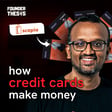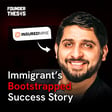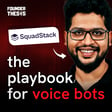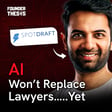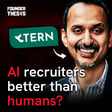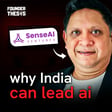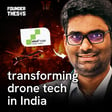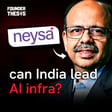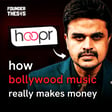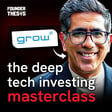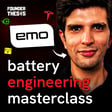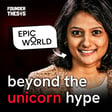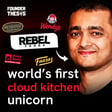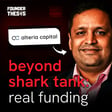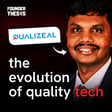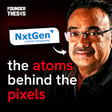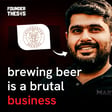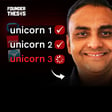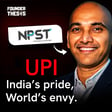Introduction and Zencastr Shoutout
00:00:00
Speaker
Before we start today's episode, I want to give a quick shout out to Zencaster, which is a podcaster's best friend. Trust me when I tell you this, Zencaster is like a Shopify for podcasters. It's all you need to get up and running as a podcaster. And the best thing about Zencaster is that you get so much stuff for free. If you are planning to check out the platform, then please show your support for the founder thesis podcast by using this link, zen.ai slash founder thesis.
00:00:27
Speaker
That's zen.ai slash founder thesis.
Founders' Journey into D2C
00:00:31
Speaker
Hi, I'm Mohit. Hi, I'm Malika and we are the founders of the MOMS company.
00:00:46
Speaker
People often say that direct-to-consumer or D2C is nothing but old wine in a new bottle. But this episode is an explainer in the fundamentals of building a new-age brand and how it differs from traditional brands. Mohit and Malika are the husband and wife duo who founded The Mom's Company after a personal challenge as new parents looking for the best skincare products for their kids made them realize the gap in the market.
00:01:11
Speaker
Malika is a passionate mom-turned-entrepreneur and is really the best brand ambassador for the Moms Company. And Mohit is a McKinsey consultant-turned-entrepreneur who helped Malika build up the Moms Company. This episode is a masterclass in building and scaling up a D2C
Inspiration from London and Parenting Insights
00:01:27
Speaker
brand. And here's Mohit and Malika telling Akshay about how it all started.
00:01:35
Speaker
super, super kick-ass in McKinsey to be able to make it for two subsequent cycles. And holy, if you've done it for two subsequent cycles, do you sort of make the cut to be eligible for the London office in McKinsey? So Mohit got the opportunity, he made the cut, which was anyways hard. And then I was five months pregnant. So then came a discussion saying that as five months pregnant, do you move now or do you not move? Should I go now or should I not go?
00:02:01
Speaker
But I think the opportunity was too good to say no, so we decided to leave. So I quit my job from ICICI and moved to London with Mohit and Mohit sort of went in there and lined up having our first daughter in London. And yeah, I had a blast in London. I think one of the best decisions we made, a large part of why even the moms co-exist and started sort of came up from us to head London as well. There's this thing that I keep telling a lot of Indian moms have saying that we do a lot for our kids.
00:02:30
Speaker
And internationally, people don't do too much for their kids. And I think I ended up in London, and that myth was broken. And how? Because most of the moms made me feel like I'm not doing enough with my child. And as I sort of fell into that typical mom guilt thing, because feeding our children was what was really pushing it really hard. But they were constantly working on stuff that could help them improve their brains.
00:02:56
Speaker
you know, help develop the brain properly. Then there was stuff happening around taking your children out. There's a very, very strong thing of spending time with family and spending time with children and taking them out, right? Making time for families, big concept there. So I think there's a lot of that happening. And during the course, you move five months pregnant to a city, which doesn't have a doctor, which has a lot of doctors, because you don't get access to doctors because you get into NHS.
00:03:25
Speaker
And with energies, if you're pregnant, you basically get midwives there. So starting from a space where you're like, you have a lot of doctor attention to going to not seeing a doctor and figuring out who you consult with, where could you go. And energies, the doctor doesn't take the decision for you. So they give you with a lot of reading material and you make your own choices. So I think it just taught us to be more aware of what we were choosing. And that kind of stayed with more and more than me throughout our journey as parents as
Identifying a Market Gap for Natural Skincare
00:03:53
Speaker
So how did you end up starting bombscore then? We came back in 2012, sometime towards the end of the year where we had this little concern that Mayra had on her skin. And I kept asking doctors and they would keep giving me this steroid-based cream. And I would keep putting it, but the condition would come out somewhere else and it just sort of kept happening till I met this one video actress who told me that this is because of dry skin.
00:04:17
Speaker
And I was almost in a state of disbelief because I was using a really good moisturizer and also the fact that I had gone through so much trouble trying to figure out what her skin condition was and the doctor was just saying it's not good moisturization and immunity in the moisturizer. Once the start of when she told me this was like the question started in the mind saying, why is this moisturizer really not moisturizing? And as a parent, you used to questioning what you were choosing.
00:04:41
Speaker
And when I started questioning more and more of what was there in the product, why was it actually not doing the task it was supposed to do, was where it relies that a lot of products have a lot of ingredients that are not classified as safe globally. And there were a lot of brands that were using those ingredients. So one was that the other was because of her condition, she needed antigen-free, fragrance-free products which are not available.
00:05:06
Speaker
And the more the question I would ask to the Indian mom saying, what are your options? I realized that they didn't have a very choice, very clear choice of brand that was theirs. And that's how we said, I think there's a space in the market to create something in the space of natural, organic, safe, effective. And then sort of took that leap of faith to sort of figuring out, can we do that in India one? And if we can, then what does it take to kind of make it work? And that was how the moms go started, actually.
00:05:36
Speaker
Okay. So, Mohit, let me ask you this, like, what was that?
00:05:42
Speaker
journey from realizing, okay, this is a gap in the market to actually shipping the first set of products, like from that idea to...
E-commerce and Trust Building in Moms
00:05:51
Speaker
It's very interesting, right? So what Madhika said in parallel, what was happening with me was I had gone from McKinsey to Snapdeal, and I was heading growth and strategy with Kunal and Rohit. And what struck me about that experience was that I walked away thinking the true consumer of internet in India,
00:06:11
Speaker
is going to be the mother because she is living on a budget. She is now discovering a lot of new things on Instagram and Facebook and Facebook groups. She has across India historically not had too much access to newer brands except what's available in retail near her house and now e-commerce is enabling this entire retail journey for her.
00:06:34
Speaker
So when Madhika said, here is a problem area that we must solve and let's make sure moms don't have to go through what we went through as kids, for our kids. I came at it very differently saying if I was to combine e-commerce and social media, then there's possibly a brand that can be built. And this was when DNVV was all over the place.
00:06:55
Speaker
in the US, but D2C in India hadn't even started, right? Five years ago, it's now a big rage, but at that time, nothing. It wasn't done, right? So when we spoke to people, they said it's impossible, but e-commerce and social media, I think was fairly quick. The biggest challenge that Madhika and I had actually was, this is a category, if you think about it, it's quite a stupid space to start because the amount of trust you need to build with a mom as a new brand is extremely high.
00:07:19
Speaker
Why would someone ask an unknown brand, an unknown label for something as sensitive as their kids? So, Madhikhandi actually spent a lot of time getting the brand right. We got Shreepa Nakani as a mentor. He's the guy who built Johnson's in India, then went on to consult with 250 other brand gurus. So, we got him on board as the mentor and advisor. He had a very significant role in the journey.
00:07:43
Speaker
We got a manufacturer after a lot of fun. The one manufacturer that had actually been with Gamma or with the India start and had been forest essentials at their start, right? So very amazing scientist, formulator who was going to create very high quality products.
00:08:01
Speaker
had a factory. So we found that and you convinced him to join us in the journey. So it was very interesting putting all these pieces together. And when he was starting, I remember this, another founder told us, your first step of getting stuff out will take you three times the time that you estimate and three times the money you make. And both of those came true.
00:08:22
Speaker
So you walked in saying the brand is done and the products are ready and it took us exactly nine months from start to actually getting our first three full products out into the market.
Initial Funding and Brand Building
00:08:33
Speaker
So how did you fund this? You must have been paying for brand consulting and you would have to pay something to the manufacturer also. How are you funding all this? So we put in the little bit that we had and we also raised a very early angel round, friends and family round of 1 crore and 15 lakhs and that funded it. The biggest bet we took was a large chunk of that we put into the brand.
00:08:59
Speaker
because we said the brand is what will stay with you first. So brand was the top spend out of that and then getting the product was the spend out of that. And of course, the second month of launch, by that time, people knew what we were going after and we got DSG and Sama as VCs on board and did our phone check about 12 months after that Angel Round was closed. Wow. So when was the Angel Round closed from a timeline?
00:09:24
Speaker
So we decided to do this by March 2016. The Angel round, we closed by about September. So we closed that first Angel round about six months after we started the work. Okay. So when you say spend on brand, what all does that include? Like are you talking of the imagery, like spending on good quality photo shoots and website or like what all does it include? Like to really invest in a brand, what does that mean?
00:09:47
Speaker
So a lot of things over time, I tell you at the start, it meant getting the best designers available to create the brand identity for you. And this was a brand identity where we said, like we said, building trust in a category like mom and baby care is very, very hard.
00:10:03
Speaker
And the design that you choose and how professional it looks and the color scheme and the fonts need to marry that. So the decision making of what the brand should look like, we had two very different routes and the one we eventually met with. So it was everything from what should the brand name be,
00:10:20
Speaker
What should the color be? What fonts are you going to use? What sort of packaging will you use? And because we knew always that this has to be a much larger vision that we want to go after, we want to help moms do everything possible. So that even in the early start, the question was, even though we are launching in pregnancy, in fact, which was the first category, how will this packaging scheme evolve from pregnancy to baby care and beyond that as well, right? And all of that thinking had to be done upfront.
00:10:47
Speaker
What I find today with a lot of founders, especially back when we were there, we had a deep passion about solving a problem.
00:10:58
Speaker
And what I find most founders get stuck on is what next? Let's say I do solve this problem phenomenally well, but I've taken on VC money. I need to keep growing bigger and bigger. And you created such a sharp brand that while it did fantastically for the niche you started with, you get stuck as you go forward.
00:11:17
Speaker
And we had that sort of advice and so we were preempting that with the branding early on. And what a name like the Momsco allowed us to do from the very beginning. It was very clear that we were not baby soap brand. We were a brand that would solve everything for moms over her lifespan and over her journey. And all of that had to be built on those very early roots and building blocks of the brand that we created.
00:11:40
Speaker
Essentially it allows you to present yourself as a, like a larger feminine beauty, wellness brand. Yeah. Yeah. I mean, it's seen stupid at that time, but I'm glad we did it. We had with the Momsco name, we had four categories drawn out of what the Momsco would look like in those four categories. We had renders of storefronts, right? Where the Momsco name was plastered.
00:12:11
Speaker
Thanks to your McKinsey experience that you were able to take this as a consulting assignment in terms of the detailing that you did. I think the consultant experience made me realize you need the best mentors and guidance in the front. So we had Fripa on one side but we had Nandu also who retired as a global board member at Nestle.
00:12:32
Speaker
And we also got in touch with him and got him as a mentor. So a lot of the decision making and what to do, especially in the early days when you're setting it up came from them. I think Madhika and we were very clear from the start that this is an area we need to solve and we really want to create a big meaningful business out of this, but we don't know it. And so the best mentors possible and the best agencies possible, best investors possible is who we need to create. And it's really that ecosystem that will build the brand. Madhika and Nia are the enablers for that.
00:13:01
Speaker
What gave you the comfort to take this risk, Malika? Like going and asking friends and family for money is like, I mean, you're putting yourself on the line then, if it doesn't work out.
00:13:12
Speaker
No, I think if you ask me, I was extremely passionate about building this. I saw a huge opportunity in it. And we really actually did not take too much of family money. And in hindsight, it is the biggest sour point that everybody in the family has today. Saying that we all offered and we refused to take. I'm only logic at that point of time was that you did not know how this would play out, right? This is a very new concept. When we started,
Understanding Indian Consumer Aspirations
00:13:33
Speaker
we were the early people.
00:13:35
Speaker
who started off on the D2C journey, right? So we hadn't seen how it would play off, so we actually told family to stay out. There were some very interesting friends and mentors who came along the way and for them it was all about the idea and the fact that they wanted to attach themselves to the idea and that's of course the background. That boy had a few people who had worked with him.
00:13:54
Speaker
wanted to put in money. I think very initially when you put money, you put money on a large part of it is on the founders and the founders vision. And a little bit about whether you sort of have any kind of understanding or affinity towards what they're building, right? That's largely what it was. But I was very sure that there was definitely a gap in the market and it had to get filled. And I thought it was a really large opportunity and
00:14:23
Speaker
We often tell people, for me, I think the biggest moment of truth or the fact that this could be big was when, in the process of while we were doing the brand building and we were working with this agency too, kind of the largest expense is what Mohit spoke about, right? From that 1.12 clause that we had raised was when we were doing consumer research and in consumer research, we were
00:14:45
Speaker
going to interview a family and a lady in South Extension. So for people who don't know, South Extension is one of the most premium localities in Delhi, right? But what we did not know was that it also has a little part to it, which is not the affluent society.
00:15:02
Speaker
Yeah so when i ended up going there and once we reach there i was kind of looking at the agency saying because i couldn't i couldn't i couldn't take my car inside like i had to pop the car outside we walked up to the building it was a really large building but the building was split by different colors.
00:15:18
Speaker
And it was only later that we realized, you know, sort of sitting in and very, very film me if you could just portray it like that, right? Like we had a few Aunty sitting down, a few kids playing below. And one child came in and said, what are you doing? And I said, what are you doing? He said, come, come, I'll take you there.
00:15:34
Speaker
And we like that one building a different colors meant the houses on every people's house and is different. So you went to this lady's house. She was about four months pregnant and we entered the house and you enter into her kitchen and a welcome sort of a space. And then there's a bedroom.
00:15:50
Speaker
And that's it. That's the entire house. So our entire interview actually happened in her bedroom. And there's a small bedroom on one side, there's a life-size marriage paper portrait. And the other side is a little TV. And that's where you do. We sat at the bed, we're interviewing her. And while we're interviewing her, we realized that she had gone multiple times to the body shop store to make a purchase.
00:16:14
Speaker
And she not purchased it from there, but she constantly went in to keep checking on what it was. So she apparently bought some set from L'Oreal, which was 3000, which was spoken of completely in the whole course of the event, at least four or five times. But the fact that she actually took that money out to buy something for herself was really interesting for me. Right. And that sort of said this, this is a new version of Bharat coming up where everyone is extremely aspirational in nature.
00:16:41
Speaker
And Redmi wants something which is good for them. And I think she was in a large part of the reason where I got my conviction from, right? And I walked off from that meeting and I told her, if we, actually not after the meeting, it was before the meeting when she was walking up and she said, where have we come? And I turned around and said, but you know, like if this is where we can reach, then we have a huge, huge market. And it was just that the woman had spent so much money on her skincare. So it was extremely interesting for us.
00:17:09
Speaker
And that kind of, you know, again, sort of went back to saying that, yes, I think we could do it. I think the doubt was, the doubt really unpredictable at that point of time, because neither had natural picked up and those conversations had not started off being safe. We weren't the pioneers to start another conversation.
00:17:26
Speaker
So whether the idea will hit home or not, which is where the brand we excited that Mohit spoke about was not just packaging, but it was also what would the brand stand for? What would be the brand's identity? What would be the brand name? What would the brand communicate first, right? And what are the first things we said there? The conversation that you were having on, did you spend on photography? No, we never spend on photography. That Mohit had, when we were having Myra, our first daughter, Mohit bought his DSLR.
00:17:54
Speaker
and got used extensively there. And it gets extensively used for mob school sports because all of this was happening in our home. Because, you know, like when you raise money from very close friends and family, you're very, very careful of where you're spending. We never took a salary for almost about two years while we had their money, right? And then all we did was call friends and families, their kids, to mortgage on us. The photo shoot happened, which sometimes we were doing the photo shoot, sometimes I was doing the photo shoot.
00:18:22
Speaker
much later than we actually got professional photographers, professional videographers to actually do the whole set of shoot. But yeah, as a large part of it just went in defining who the mom's school was, what the mom's school was, what would it do, what would be its values. And I think that as a brand book was what we could have spent the first set of monies on.
00:18:44
Speaker
So a body shop must have been both an inspiration and a potential competitor. Essentially, you were building a body shop from India with a similar promise of nothing which causes energy, nothing artificial, no chemicals kind of products.
00:19:02
Speaker
Actually, you know, maybe the proposition was quite similar to what Body Shop was, but what we were building was not really another FMCG brand. What we were building was a brand that was for the mother and for the changing mother of today, right? Like she wanted some brand which she could trust. It was if you go back in time and we were growing up.
00:19:20
Speaker
our parents took a particular pride in saying that we are ex-babies, right? And it was largely because of the brand love that that particular brand owned. But over a period of time, it just sort of lost its job and nobody else managed to replace that with anybody else. And the idea with the Momska was, as the woman enters her journey into motherhood, all the way till her child is fairly glued up, can we be that one partner for her? So it wasn't, it was never meant to be and still isn't.
00:19:48
Speaker
just another brand, it is more of a partner. So that was the intention with starting the law school.
00:19:54
Speaker
So Mohit, tell me about which category launched first, what kind of numbers did you see and how the business part of it was shaping up. So we started interestingly in pregnancy first. Pregnancy was as a category when we looked at it versus baby care. What we found that while for baby care, retail is possible, for pregnancy it just isn't. Because women go through that as such a short duration of time. In retail and in offline for you to find any
00:20:23
Speaker
cohort of pregnant women around the shop is fairly hard. It's a possibility to build a pregnancy brand offline and we had seen no innovation in pregnancy at all online. So rather than go head on and baby and burn a lot of capital that we started in pregnancy first. It was a very interesting category because I think within a month of launch, we were already best sellers on Amazon.
Successful Product Launch on Amazon
00:20:43
Speaker
Well, so you directly lost our marketplaces. We did it in our marketplaces. And again, the logic there was, what do we want moms to build trust on? Do we want them to trust the Momsco as a brand? And therefore the brand is available everywhere and the best seller in maternity. Or do we want the Momsco overtime for them to trust our D2C website? And again, D2C wasn't big, right? For five years ago, websites were still new. So we lost the pregnancy first. And for the first year, we did only pregnancy care.
00:21:11
Speaker
And what that did for us is it helped us build our own credentials in learning moms and moms trusting us. It got us to bestsellers in certain categories very quickly. And very interestingly, in the first few years, we were actually betting big on the entire doctor channel as well. So when we as a completely new brand went to meet gynecologists with the product,
00:21:34
Speaker
Their first reaction was, where were you guys when I was pregnant? Because they had seen no innovation in the category at all. And so that really helped us get supporters within maternity. The top gynecologists in Delhi and Bangalore started recommending the product, again, learning on trust. So this was our first year journey. It worked really well in establishing. What were the products in pregnancy?
00:21:55
Speaker
We had India's largest range of pregnancy products, which is four. Right. We had a body, but at the stretch mark and a body wash, which also helped with nausea and morning sickness. And we had a foot treat swollen feet and ankles. And so very large portfolio from maternity perspective, because people that only said stretch marks so far. Yeah. Yeah. Yeah. All right. Right. So that did very well. And what kind of numbers like what kind of. So the end of the first year we were talking about, I think about 25, 30 that's a month.
00:22:22
Speaker
Okay. And this was after DSG had come in. Yeah. So DSG Sama came in because they had been looking for baby care in India as a space to invest for a long time. So they actually committed when we were doing two lakhs a month. Our second month. What was the size of that check?
00:22:41
Speaker
a million in the first round. Year one primarily around the pregnancy, 25 lakhs a month you ended year one. And the entire idea was to build trust. And at the end of our first year of being maternity, then we went into baby care.
00:23:01
Speaker
And then the second year we launched baby care, then the third year we expanded that for the bit. Second year would be like 17, 16 you started right? No 17 was the first year, in fact in a few...
00:23:15
Speaker
In a month or so, we'd be celebrating five years as a brand. So March, 2017, we launched 15th of March, 2017, exactly 15th of March, 2018, we launched our baby care range. So that's about four years old now. And then like what all products maybe was the word put for you, right? We had spent about two years developing the entire range. So we did a baby wash, shampoo, hair oil, massage oil, baby powder, diaper, ash cream.
00:23:40
Speaker
that everything, eight products, which is all the basics that the baby needs with similar very high product quality clinical trials in all sorts of testing, all natural certified toxin free. I guess you must have been like neck to neck with Bama Earth around that time. They also were pretty much around, I think 17, 18 is when they... Correct. Very similar timeframe.
00:24:04
Speaker
And what was your customer acquisition strategy? How were you building awareness and getting people to buy? How are you generating sales?
00:24:14
Speaker
See, we're very clear from the start that we are going to be a mom-focused player, right? We never really said that we're going to become a very large, generic personal care brand. And so all of our marketing strategy revolved around that. A big part of our customer acquisition was Dr. Lead. And we spent a lot of time. In fact, we were the first brand in India that created a shop-in-shop model inside hospitals.
00:24:36
Speaker
So we had the first stores that were created in waiting rooms and our trained mom counselors would actually work with the moms and tell them about products and ranges and why our products were different. We'd work with doctors to educate them about the products and ranges. And that was a very large piece of the strategy.
Customer Interaction and Brand Growth
00:24:54
Speaker
We did that for about two years. And then as COVID hit, we actually moved away from the doctor-led model to going more into mass retail.
00:25:01
Speaker
Right. So that was a big part of the strategy. And then the second part of it was working very closely on online, right? Malika was constantly on various Facebook groups, looking at what's happening over there. Very closely connected to the entire mom influencer ecosystem. And they were a big part of the supporters, you know, for us. Malika, maybe you can talk about this, like in terms of how you generated awareness, buzz, like what all stuff you did to really drive up sales.
00:25:26
Speaker
So I think, as Muvit said, of course, it was the usual stuff that we were doing on our D2C site and on Amazon. We were the first two partners we had, but other than that, I think what we did was very, very basic stuffs of welcoming everyone who came in. So our first set of consumers were actually people who came through the LinkedIn posts and the social posts at Muvit and I had put on our own social handles.
00:25:47
Speaker
And from there was where the journey started, right? And of course there was discovery, which was happening, but what we did was every person who in the order that got delivered, we would make sure that there was a very personalized touch to what we were doing and we could kind of narrate to them and tell them what is it that we were trying to do. And that, of course, like during the course of it, we will try our best, but if they make any mistake, kindly let us know.
00:26:10
Speaker
What you like about us, let us know. What is it that you don't like about us, let us know. And Modhana used to actually make customer calls constantly. Anyone who shopped, we would call them and say, where did you find us? How did you know? Where did you first see us? When you bought us, what was the thought on your money? And you would do all of those calls as well. And I think it was these calls that helped us articulate the message that we wanted to tell people at large.
00:26:36
Speaker
And while all of this was happening as he said right March 2017 was when we launched our pregnancy range and one year later was when the baby care dead age launched. The baby care range actually launched with a brand film which I had shot with my daughters in my house. And a large part of it came from the fact that the authenticity of why you are doing what you are doing
00:26:58
Speaker
was what something was hidden for everybody else. It was the moment in my background that kind of got the first set of consumers saying that you're not just any other FMCG player but your parents who are looking to build and create a better world for their children, right? And then I thought and the fact that you used to import initially before you started and I also import that these stories are very relatable to everybody else and we did a lot of storytelling in the first year.
00:27:21
Speaker
year and a half. But then later, what parts of the story and that story had hit home and when we knew it did, we actually created and packaged it in a form of a video and then started talking to a lot of people about it. And that was when the first film went on. Various mass media platforms, not very, very mass, but to spend that an hour due to do whatever. It was where we went with those messaging to a lot of people.
00:27:43
Speaker
But I think before that, also what we did was to get a larger buzz in Banyar.
Influencer Collaborations and Community Building
00:27:48
Speaker
Of course, there was a sharp growth in the one year, but we took help of a lot of influencers to kind of let them know and let their audience know that, yes, moms co-exist. We sort of collaborated with a lot of Facebook groups, parenting portals, because our audience was there largely. And then we started doing conversations through them to get our first set of adopters.
00:28:10
Speaker
And with every person who came on board, our only mission was to make sure that one customer actually gets another five. And then those five get a lot more than 10, and then 10 don't do much more, right? And which is where everybody had their own personalized referral codes, everybody had their own personal things where they could make benefits out of growing us and growing with us.
00:28:32
Speaker
And I think what was the most beautiful and differentiated about us, Akshay, was the fact that we became, as what we wanted, we became a part of people's lives. We would get stories where women would say, saying that, I have your body butter and your body butter is a part of our nighttime regime, where I and my daughter sit together and we apply this lotion to moisturize ourselves over the
00:28:53
Speaker
Winter, there was a lady who was on her way to delivery and who called us up one day and said that it was a call actually at 10.30. And as I said, we were customer care, so we would pick it up. And I was like, what is 11 o'clock? Should I pick up the call? And he said, you know what? I sort of picked up the phone. We weren't doing much. And I picked up the phone and the lady was like, at least in order, can you make sure it gets delivered in the next two days?
00:29:14
Speaker
We were like, yeah, on a short show, like if you want us to do it, then next day. So when are you expecting your baby to be out? And then she was like, I'm on my way to the hospital. And that is, these are the moments where you're like, okay, if someone can remember you on the way to the hospital, when they're having their first child, then they're never forgetting you.
00:29:35
Speaker
And of course, we paid extra money because we couldn't afford very sharp, very fast, very speedy shipping at that point of time. We paid extra money for her to make sure that she got it when the product reached to her. And those were the stories that we kept building on. And those were the stories that we kept maintaining our relationships with. It was the box that we wanted, the box that they had to become one of our best sellers.
00:30:00
Speaker
Because what we did with the box then was the fact that if you want to have it as soon as you have your child, then what that essentially means is that it is something that everybody should aspire to be. So we have a round box for pregnancy and we very quickly started seeing that and we very quickly seeing that that became a symbol of announcement in pregnancy.
00:30:20
Speaker
There was a celebrity who actually put up a post saying that I finally got my mom's school box. And now I think that was what we kept picking up from every of these consumer interactions and kept building onto them and started making marketing stories out of them and started creating buzz. And that sort of hit home with everybody else and made us what we are today. So essentially instead of investing in like performance marketing, you were investing more in content marketing.
00:30:48
Speaker
Yes, for the initial one year, yes. We didn't start performance marketing in about six months of our start. But of course, you don't have a very high budget to spend very large amounts. There were, of course, little spends that they were doing on performance marketing. And then, of course, now we do spend a lot on performance marketing.
00:31:05
Speaker
But yeah, I don't know what this additional day is, and then it's really nice. I think it's very interesting because more than I've never done a podcast together, I think. And this one we've done after very long, but maybe just one is what we've done together before. And all these conversations are just taking us back the memory lane where it was about six years back, saying, Oh yes, we did that. Oh yes, we did that. So I'm sure that the end of the recording, we're going to have a call sent with set up with all our marketing teams saying, listen, we're not doing all of this anymore.
00:31:39
Speaker
That 25 lakhs, once you launched Baby Care, next year what was it at? What was the trajectory like? With Baby, we were very soon doing about a crore, crore and a half a month total.
00:31:52
Speaker
Then a lot of moms actually started coming back to us and saying, I'm not pregnant anymore, but I still love your products. Can I use them? And that expanded us. That got us to thinking, saying, in fact, that was the eye opening, I think, moment for us when we said maybe the definition of mom that we are thinking of is very narrow, right? Just pregnancy and post pregnancy. Once she's a mom, she's a mom for life.
00:32:17
Speaker
And over the years also moms became more aspirational. The mom influencers started creating this entire idea that when you are a mother, you don't need to give up on everything else in life. You can be a mom and have a career and be fit.
00:32:32
Speaker
and look good, right? And it's all about taking care of yourself. And that allowed us to expand the definition of the mother to include all of these other categories. So then we went from pregnancy and baby also into face care. For moms, it's a very large category and a very big concern. So we launched Healthfall and went into care after that. And of course, as you expanded the categories and the definition of moms, now that's when we started donating about 150 crores. That journey took us about two years to get to.
00:33:01
Speaker
150 karos annual, that's amazing. When did you hit 150 karos, which year? This was about two years after that.
Pandemic Strategy Shift to Mass Retail
00:33:10
Speaker
Like 20 maybe, like early. Yeah. March 2021. So 2021, right in that timeframe, yeah.
00:33:16
Speaker
So how did pandemic influence your strategy and your distribution channels? Like one quick question. So initially you started on marketplaces. When did you launch your own D2C website? At the same time. So launch both at the same time? We did D2C at the same time. I think that's been fairly consistent over what's really changed with the pandemic. It opened up retail for us.
00:33:40
Speaker
Like offline. Offline retail. So we had, again, driven by consumer insights. So consumers started calling us and saying, how can you be so irresponsible? Right?
00:33:52
Speaker
Ecommerce is short. You are the only thing I use for my baby. If you cannot deliver to me, do you expect me to use some other brand? That's you being an irresponsible brand. And for us, it was an insight to say we probably reached a space in the lives of our consumers where at least in the top cities, we need to be in offline retail.
00:34:12
Speaker
So, interestingly, when the world was shutting down retail, those three weeks of e-commerce being shut opened us to the opportunity that retail had. And how by thinking about the entire doctor network, maybe we were delaying the retail journey for us. Doctors, anyway, that entire channel wasn't working with pandemic people. There was a lot of scare and hesitancy. There were no waiting rooms anymore. So, we shut down that team and that business, which was doctor-led, and we pivoted that to being more massy retail.
00:34:40
Speaker
And so in the next few months, when retail was looking for, hey, how do I get consumers back into stores? We went to retail and said, we will be one of the partners who help you do that because we have significant offline. And so we went and partnered with a lot of modern trade stores. We went to a lot of pharmacy chains, beauty chains, and they use the Momsco as a pivot point to say, consumers, why don't you come back? We now have the Momsco in our stores as well.
00:35:05
Speaker
So while the D2C and marketplace journey continued accelerating because consumers were now moving online very quickly, that journey we got faster on with a lot of product introductions and I let Madhika talk about that journey. But on the channel front, it was really how do we go crack deals which you wouldn't have got earlier and expand into retail during these six months of the pandemic.
00:35:32
Speaker
If you like to hear stories of founders, then we have tons of great stories from entrepreneurs who have built billion dollar businesses. Just search for the founder thesis podcast on any audio streaming app like Spotify, Ghana, Apple Podcasts and subscribe to the show.
00:35:53
Speaker
Okay. So like 2020, what was the split between marketplace and own website? Like which was? About 70-30. The marketplace 70 and website about 30%. Offline was 5-10% at that time. Correct. So, and what is it today? Like offline, own website and marketplace? Depending on the months and of course, we've jolied a bit given the market scenarios. Roughly we do about 60% marketplaces, 20% website and 20% offline now.
00:36:22
Speaker
So what about the new product launches, Malika? Like you want to talk about that a bit?
00:36:29
Speaker
So we have a very interesting set of about some 20 odd products that are launching this year. And as I said, it's again expanding. So we sort of sort of split our lives into pregnancy care, face care for moms and baby care. And we have products launching across all categories. We're also launching home care this year, which is very interesting for us. Home care. Yeah, it's a new space that we can entry. Yeah, so we're just...
00:36:55
Speaker
So your laundry detergent for kids, surface cleansers, dishwasher is in cleanser. So basically stuff that you use in your home and then because it's very close to when you want to have a cleaner, more natural space around you, when you want to protect the environment as you're protecting everything else, a cleaner range of green products for home use.
00:37:17
Speaker
So what sells well on which channel? I mean, either of you could answer this. Which products sell well on marketplace? Which products sell well offline? What are the trends which you have seen?
00:37:29
Speaker
They're very similar chance because it's actually what people haven't said. It might be the contribution per channel might be very different. For instance, Naika will have a lot more of beauty portfolio that gets over there. Amazon has a
00:37:52
Speaker
has even a very higher contribution that comes from Baby as well. Your website, of course, is your brand site that sells both products. Retail, typically, whatever is selling online, it kind of mimics the same platform and the same this thing called selling offline as well. So pretty much similar spends. There's sort of massive difference that we have seen in SQs across channels that are dramatically different from what anywhere else would be. So I think it's pretty similar in terms of sales.
00:38:19
Speaker
What are the top-selling products? We have an under-eye cream, which is a best-seller and has been a best-seller for the last two years across all platforms. It's one of the market leaders in the space. It's a very interesting concept where we used coffee to help remove dark so-called buffiness.
00:38:40
Speaker
And it comes in a very interesting roller format. So the format allows you to also gently put a little massage on the under-eye area. So that's one. Our gift box, as I said before, the pregnancy gift box and the suitcase that we have for baby, those do exceedingly well because there were very high gift options. Plus, people just sort of find it very easy where they get everything in one space and they can just pick it up, right?
00:39:03
Speaker
view of those. And from our very recent set of lodges, we have seen these products in terms of face washings, which are doing really well. So our vitamin C face wash has really picked up and our new range with vitamin C is also doing quite well. So I think fairly distributed across baby pregnancy and face care.
00:39:22
Speaker
So tell me about how you do product development. Like you were talking about this under eye cream, which has an innovative form factor. How do you go about doing this? Like is there like a agency that helps in designing it or do you look at what's going on globally or, or do your manufacturers tell you, okay, this is something which I can make or, you know, how does that happen? Like new product development.
00:39:46
Speaker
So the new product development completely happens in the company within the company. We don't outsource it to anybody. No part of it is outsourced from packaging to actual sort of development of the product. We take extremely high pride in really creating products that are world-class in terms of their experience abusing. And hence what we do is we control the R&D now. And so there's a mix that goes to the R&D team and the R&D team starts working on creating the products. We are very strong guard leads on what we could do.
00:40:16
Speaker
How does the brief go to them? Let's start from step one. How do you decide, okay, let's launch a product like this? How do you make the brief in the first place?
00:40:25
Speaker
So first few ranges have been like what's not available and what needs to get created. So when you were doing pregnancy, it was a first personal experience initially where I came back and realized there is no products. And that's what you stand up creating. And I think that's fairly easier in terms of figuring out what products to launch because your portfolio is very small. So I talk about what we do now.
00:40:47
Speaker
Right? So in terms of what we do now is we try and sort of figure out what are the market needs in terms of what are the consumer facing in terms of challenges that are unmet and what are those net needs that are not solved, sort of really standing and solving for what they should be solving for. Those two white spaces that we see where we say that, look, these are the places where you want to start from first. And just one indication on what you could make next. The other indication is what is it that the consumers are searching more and more. Now,
00:41:14
Speaker
right? And whatever they talk about or whatever they search is what also goes into product development, right? Because those are going to be the needs, if not now, in about three months, six months or one year, depending on how soon someone makes the adoption. The third very interesting format that we have is that, you know, once in a month, I go and have conversation with all the followers that we have on our social page. So the mom's post page is about 240k followers right now.
00:41:38
Speaker
And what we would do is I would, all Mondays, go there and ask them questions in terms of saying this is the whole day where I would personally be answering all questions. We call it the session that you can ask Malika. Whereas as a founder, I go and speak to everybody who has any question or anything related to product, personal life, parenting journeys, anything at all.
00:41:59
Speaker
And during the course of that is also where I keep feeding in product questions on what ingredient would you like us to launch? What product would you like us to launch? And that also gives me a lot of feedback from the consumers. Once this is a product that you want to do, and these were the main asks from the product, that's when you give the brief to the NPD team saying that this is what the product actually needs to do. This is the format in which I want the product. This is the consistency, fragrance, and all those parameters get done. And then they start the work of actually hunting real activists that can actually bring a lot of efficacy in the product.
00:42:29
Speaker
And also for us, we have a much larger guardrail of what we cannot use in a product than what we can use in a product. Because we don't use any of the toxins, no paraffins, no sulphates. And a lot of other knows that people really don't know about, right? And once we do all of that is where the product development happens. And then once the development happens... You have like a life where products are being made, like mixed and tested and all of that.
00:42:54
Speaker
Yes, yes. So the products are made and tested and then they go to separate labs for third-party testings. If there is an efficacy claim in terms of whether you want to check if the product is actually doing what it's supposed to do, we get third-party clinical labs to kind of validate that with real consumer workers or with machines that kind of give you those results. And once you have all of it is where you go ahead and actually launch the product. So the testing is fairly long. It takes about six to nine months for every product to get tested.
00:43:23
Speaker
And that's the time you spend in testing, in the cost development and all of that as well. And what about manufacturing? So once you've made a formulation and you decided, yeah.
In-house Product Development Focus
00:43:34
Speaker
Yeah, so once the formulation is made and all the consumer studies and all the lab studies have happened, is when the NPD team, which is there, does something, we just call it tech transfer. Tech transfer is basically where the team goes to the manufacturer's end and actually does the first few productions. So to kind of give them a flavor of what it is and what it is not.
00:43:53
Speaker
And of course, before all of this is where all approvals happen in terms of getting their FDA approvals and all of that. But after that has happened is where the real development team and the tech team, the NPD team will actually go there and do the TechTronce or create the products. And then there's a few dodges.
00:44:08
Speaker
And then once all the checks at the same point of time, whether the product is the same as what we had made in the smaller batch, because sometimes from a smaller batch to a bigger batch, some things might change. So everything gets fixed at that point of time. So they do that. Then once those products get made in the factories, where again, the testing happens on the product at the factory's end. And once the testing is approved is where the products get packed in their respective packaging options and get shipped out.
00:44:33
Speaker
So tell me about the funding journey subsequent to that first round with DST and Sama and like till the current, like, so now I believe the good lamp group is like a majority owner now.
Acquisition by Good Glam Group
00:44:46
Speaker
So, so tell me about that whole journey. Maybe Mohith you could talk about that.
00:44:50
Speaker
Yeah, it's been interesting. We actually did three rounds of funding with DSE and Sama after the first one. Every time we will go out into the market, DSE and Sama would say, we want to double down and give us better offers than everybody else. And we just, we love them. They're fantastic investors who really know how to build brands. So we stuck with that for a while.
00:45:10
Speaker
Give a timeline also. So we did a fourth round in almost every year. So 2017 was one round. We did a round in 2018. In 2019, we did a round and then we doubled down on that round. How much in each? So in our entire journey, we raised about 10 million across three rounds after the first one. We did 9 million more.
00:45:30
Speaker
Starting last year, Madhika and me started having conversations saying, what was it take to make the amounts for 500? And we said this... And last year, you were about 50 crores. Right. Right. So about that. Surunditing about that. Like a 4x growth.
00:45:45
Speaker
Yeah. Right. So what does it take, right? Because now you're a very meaningful player in the market. You really had to establish mom and baby care as a category. We had successfully expanded and redefined mom's skincare, right? Created that as a subcategory. And so the question we started having is what would it take for us to get into 500 votes?
00:46:03
Speaker
I had to beat that and then go beyond that and beyond that. One of the options that we kept coming up with was our vision for the brand was always to solve all pain points for a mom globally. And what we were excited about was how do we take the brand global? And every time we started having conversations with investors, we felt that if it was a regular VC or private equity investment that we would, two things would happen. One is we would have reached a scale where we are too big
00:46:31
Speaker
Right. And the only out for all of us would be an IPO. And as you start to expand into multiple countries and so on, you're adding more layers of risk and potential return. Right. So that was one question which we have coming back to seeing, is that a journey that we are very excited by? Second, going back to the point, if you really want to go big globally and you have a proven business model, then it's a question of speed.
00:46:55
Speaker
How quickly can we do this? And how quickly can we launch Hindu retail which was very big for us? And how quickly can we go and launch internationally? Every time we worked back from the vision, we said much more than having just capital.
00:47:09
Speaker
What would make a big difference in the journey would actually be an investor who can come in with infrastructure. Right, retail infrastructure in India and global infrastructure to pan this out. Right, and so with that intent, we started talking to a lot of players. Where that journey ended was we had five offers. So I think very blessed, yeah, to have five offers across FMCG companies, pharma companies and the good grab group.
00:47:32
Speaker
right? All the mobile offers. And we said, of all of these guys, right? Who is the one who will give us the most importance and give us the most of a free hand to go out and scale? And from all of those answers, the good gran group kept coming up, which was my gran at the time. Uh, participant entered the journey since then, right? So yes, we completed the full acquisition in October. We continue being very deeply involved and growing the brand within the good gran group. And yeah, the journey of two 500 tours is taken off to a good start.
00:48:00
Speaker
So does Good Lab Group have that level of infrastructure which, say, a traditional FMCG company would have? Like that was what you were looking for? No, but I think what they have, they're trying to fight a very different game, right? And now I should say, we are trying to fight a very different game. I think the one fundamental belief all of us have is that brands of the future will not be built like brands of the past got built.
00:48:24
Speaker
And so the content that we have across Popexo and Baby Chakra and Scoopoo are very, very large. And that allows for a large set of traffic and very large brand introductions for you. The community or the
00:48:39
Speaker
a creator ecosystem that the Goodgram Group now has is very large. So we actually have access to the highest number of creators for any company in the country today. And if you believe creators and influencers can be a large part of brand building, then we have access to a lot of those.
00:48:56
Speaker
Retail, of course, we've started, but we don't need to be as a brand across all the FMCG touchpoints, right? We do not that much. What we need to be is being that all the touchpoints has already others and that we can build in the space of a year, right? So that retail ecosystem is getting created. The benefit we get is if I was trying to try and do this as the moms go individually, I think it's been very expensive.
00:49:20
Speaker
Because I'm doing it along with a large sales ecosystem, I get a shared cost, right? And so what I get for the same amount of money that I put in, I actually get a far wider reach.
00:49:31
Speaker
So both from a content and a community and a retail ecosystem, what I'm getting is far wider reach, a very differentiated channel ecosystem because we own traffic, right? And we can use that to our benefit far better than others, right? So I give you one other added benefit as an example. I think by the time this podcast launches, we would have launched a loyalty program that is across the entire good grab group.
00:49:55
Speaker
And so the first of a kind, you know, digital first loyalty program that takes my gram and the mom's go as seen botanica and the other brands that get added to the portfolio. So suddenly what's happening is as a brand, I actually have a chance to acquire not only companies brand or consumers for the mom's go, but consumers for every other brand and vice versa.
00:50:16
Speaker
And so there's a lot of this very, I would say, digital first new age synergy that will play out and that we are, you know, in the early days of exploring within the larger good. So essentially, good lamp would have a lot of
00:50:31
Speaker
data around consumer behavior and hence be able to target them with the right kind of product across their portfolio. These are the best consumers for Momsco or these are the best consumers. I think Peabody is also part of the group. Accordingly, they would be able to do better targeting, better segmentation. Customers of one business like Momsco customers could be cross-sold products of Peabody or Peabody customers could be cross-sold products of Momsco and
00:51:00
Speaker
And especially through the loyalty program, it becomes easier to use your loyalty reward points across different platforms. Absolutely. And then access to influencers, which would be through the content platform, like Baby Chakra and Scoopoo. So there you would be able to do better brand awareness or brand awareness at a lower cost. Correct. Yeah. And like I said, think of this as the starting point.
00:51:26
Speaker
because brands of the future will not be built like brands of the past. If I go back to earlier in our conversation, a lot of the initial growth of the Momsco came because of what we were able to do with consumer insights, picking up the phone call, doing one-on-one sort of things and activations. Our hope with the brand is that we can do a lot more of those now at scale. So then over time, what you're doing is you're differentiating yourself from a generic
00:51:55
Speaker
another me too FMCG brand. Like every brand Odyssey today is saying natural toxin free, right? Even though we started the movement five years ago, right? When everyone is saying the same thing, here is our opportunity as the MOM scope to say it very differently and to continue being on the forefront of personalization and communication with the MOM, right? That's the ecosystem that we are now building out. Yeah. And does Glamco have like an offline distribution in front of their products go offline also?
00:52:25
Speaker
Yeah, so by the end of this year, we're targeting to be in about 100,000 stores. As a group, within that group, the mom school will pick, I think probably 25,000 stores is where we'll get to.
00:52:36
Speaker
So how will that work? Like they have an offline sales team and that offline sales team will sell products across the group. Let's say any large FMCG company, right? If you look at Unity, Unity has three sales systems. One is for detergents, one is for foods, one is for personal care. That personal care sales system sells all personal care brands. I'd say they go into the same store and sell six soaps across all the brands. It's the same, right? So you have a joint sales system, which is retail. That same retail ecosystem works for all the brands.
00:53:03
Speaker
And what do you estimate you'll close this year at, like top line wise? Well, it's very hard because we're in the initial phases of getting into it, but our target is to very quickly cross the 250 mark. So I want to do like a little bit of D2C economics, maybe Mohith you can help with this. So a D2C company doing say 100 CR in top line, what percentage of that goes towards marketing spend?
00:53:26
Speaker
What percentage of that is for the cost of product, cost of packaging, cost of distribution? Can you break that down? It's different for every D2C category. I'll start from the broadest. Selling food at 100 rupees has very different economics from selling a mattress at 10,000.
00:53:47
Speaker
Right. And so the way you calculate lifetime value, do I have to capture it in the first transaction or can I capture it in the person's first year?
00:53:56
Speaker
That changes the equation and the dynamic a lot across every single category. I'll tell you the broad economics that when I speak to investors, investors are looking out for. And I think that's probably the way to look at it for now. What do they today consider a healthy business? Effectively top to bottom, they say if you're doing about 100 rupees in revenue, roughly 25% should be your cost of goods. About 20 odd percent to 25% should be marketing.
00:54:26
Speaker
So that leaves 50%. The remaining 25% for you should be overheads, trade margins, cost of goods, et cetera. There's like distribution cost, like what you pay as a marketplace commission. 95 to 30%. Right. And hopefully then there's another 10% on all sorts of other overheads, including your tea. So that in your pocket and in a better level, you're at a 15%.
00:54:50
Speaker
Those are considered great D2C economics. The way you get there is very different. So if you're selling a mattress, then ideally you spend a lot on overall top funnel, but ensuring the first order makes money. If you're doing food, you could give away the first order for free as a sample and then have a product quality. That's fantastic. So people repeat over time. If you are selling makeup, then it could be just that you sort of break even on your first order, but
00:55:16
Speaker
consumers then buy lots of different shades and colors and styles of makeup. So maybe they just buy very frequently. So that changes over time. But I think if you're selling something for 100 and you can end up at an a bit of 15, then that's very, very good economics.
00:55:33
Speaker
And how did you figure out pricing? What should you price it at? What is the strategy to take towards pricing? Do you look at what are competitors doing or do you look at cost plus, just in terms of figuring out pricing? So the Indian consumer is value conscious. The definition of value for a consumer changes.
00:55:55
Speaker
Our job when we were pricing was always to think about the consumer and say for this particular product in this category, what does the consumer consider value for money if you are a natural, toxin-free, certified, high-end brand effectively. And so the way we benchmarked ourselves was to the leading
00:56:14
Speaker
premium, mass, premium player in each category. So we continue to do that for every brand, every product. Now, of course there is a whole D2C segment, right? So new age brands are a segment in ourselves. So now it's easier you benchmark yourself against those. Earlier it was, where are you switching your consumers from?
00:56:31
Speaker
So as an example, if I think about baby care, we were definitely priced much higher than a Hemadia Johnson's. But we also made sure that we were priced much lower than a Seba Med or a set of any doctor recommended brand. And now the logic was compared to the mass brands, we are naturally toxin free certified that they can't claim to be. And compared to the clinical brands, we are naturally toxin free and cheaper. So give us a try.
00:56:56
Speaker
What about beauty products? Like how would you compare to like say a L'Oreal body shop and a Hindustan Unilever products? Like where would you be today? I think over time what we've learned to do where this for every category pickup, who is the top selling competition in our price bracket, right? So it's not just those, right? We also have competition now from a plumb and an M caffeine and a wow, mama and a whole bunch of other DLC guys. So it's the same logic, right? We say, what are those guys offering at what price points compared to that? Why should a consumer choose us?
00:57:26
Speaker
And that's how we do the pricing for every product. Does the cost of distribution change from online to offline? Like online you would pay like a margin to Amazon and you would have worked six cards. I think it was very different because it was deeply discounted in online when we started. Over time I think it's become more or less similar. Most brands are omnichannel now, right? There are cases where the distributor sells online. If the economics are very different and online
00:57:54
Speaker
is cheaper, which means that you will end up discounting more online, which means that your offline retailer will buy from Amazon rather than buying from your distributor, right? So all of those dynamics have played out in the last four to five years. So I'd say today it's broadly equal, right? Any online retailer is as good as any modern trade retailer in the country today. And you said you're, you're very, very hardworking. Do you like, how do you manage being a mom and a founder? Because like, are you able to really give enough time to your kids? How does that get balanced?
00:58:24
Speaker
No, it doesn't get balanced. It's a massive imbalance. Okay. It's a massive imbalance then. But I would initially start off with the typical mob guild that everybody has and shrug over it and doing what it was. They landed on this one particular instant which led me to give up all of that. And gone for an award ceremony came back from an award ceremony and that award was like really large. It was a really big piece of award that I got. And my owner, daughter, once fine day decided to hold that little award piece and then she drove around with it.
00:58:54
Speaker
And I said, what is this? What is it that you're doing? She said, this is my new dress. And I said, it's a dress. She says, yes. And I said, OK. And she said, this dress is called pride. And that was the day I decided that this is it, right? And I often tell my daughter, Snake, I might not be there to read your nighttime book every day. I might not be there when you're eating food every single day on every meal sitting with you, feeding you. But on any particular day when you think you need me,
00:59:24
Speaker
Or when you would want me around, you would always find me. And I would be the first one who would always be there. And that's the message that I've told them. And then if I haven't missed a single recital they've had, I've never missed any PTM that they've had. I haven't missed any important decision-making for them. So I haven't done any of it, but I haven't gone for every class that they go for either.
00:59:45
Speaker
But that's how we're living. I think they're growing up to be very fine children. My older daughter has a company name, a tagline for the company. I think that's the one she wants to do. Her aspiration, one year back, she wants to raise $6 million. She started her own company, so I think they're good. Giving care of better balance would be good.
01:00:12
Speaker
Amazing. And Mohit, what are your learnings, like things you would have done differently?
01:00:18
Speaker
I actually have a list. I was going through my list in parallel to see what's going on, what's sides, and maybe I just end with this one thing, right? A large part of where we've got you today is thanks to mentors and having a set of people who we can reach out to, to guide us over time. Now, as today I do my angel investing and speak to founders, I find one of the most common mistakes founders make is believe that they need to know and solve everything.
01:00:47
Speaker
It's not your job to solve, it's your job to get it solved. It's not your job to do, it's your job to get it done. And as a founder, if you're able to step away from the day to day and actually guide the business, either by hiring the right people or setting the strategy or getting the right investors, I think that is the most important role that you can play. An incredible thread on this is it's very hard to read a label when you're inside the bottle.
01:01:14
Speaker
Yeah. Fantastic. Right. So you're, you're like, Malika is constantly working, right? I'm constantly working. We are knee deep into the problem of the day. A mentor just helps you read the label from the outside. And yeah, so get a very sharp set of mentors to help you out in your journey. And that is dramatically improve your chances.
01:01:35
Speaker
What kind of angel investing do you do? What is your thesis as an investor? Are you sector specific? What do you look for? So a few spaces, I do a lot of angel investing in the D2C. Enable the space.
01:01:47
Speaker
Right. I think D2C is going to go under a massive boom. And when there's a gold rush, you should set a shovel. Right. So those who are like creating Shopify like products. Yeah. I think it's insane, right? Because you will be an enabler to a lot of journeys and a lot of brand journeys. So I do that.
01:02:05
Speaker
I selectively do D2C brands as well, which I think will help create a lot of categories like the moms go out and create. I think category creation is expensive, time taken, but has the highest chance of success in the long run for investors. So now that's my investor hat on. Beyond that spaces, which I don't know as much beyond D2C, it's all about the founder.
01:02:25
Speaker
Thanks to people who I've worked closely with and who I trust, if they put their trust in a founder, then my point is I will give you my advice and insights. And if I think that you will listen right as a founder, you're open to mentorship and you will listen in whatever shape and form that I can help and have a meaningful difference, then I invested those. So that part of the portfolio is not sector specific.
01:02:46
Speaker
If you like the Foundathesus podcast, then do check out our other shows on subjects like marketing, technology, career advice, books and drama. Visit the podium.in for a complete list of all our shows.
01:03:06
Speaker
Before we end the episode, I want to share a bit about my journey as a podcaster. I started podcasting in 2020 and in the last two years, I've had the opportunity to interview more than 250 founders who are shaping India's future across sectors.
01:03:22
Speaker
If you also want to speak to the best minds in your field and build an enviable network, then you must consider becoming a podcaster. And the first step to becoming a podcaster starts with Zencaster, which takes care of all the nuts and bolts of podcasting, from remote recording to editing to distribution and finally monetization.
01:03:43
Speaker
If you are planning to check out the platform, then please show your support for the founder thesis podcast by using this link zen.ai founder thesis. That's zen.ai founder thesis.

